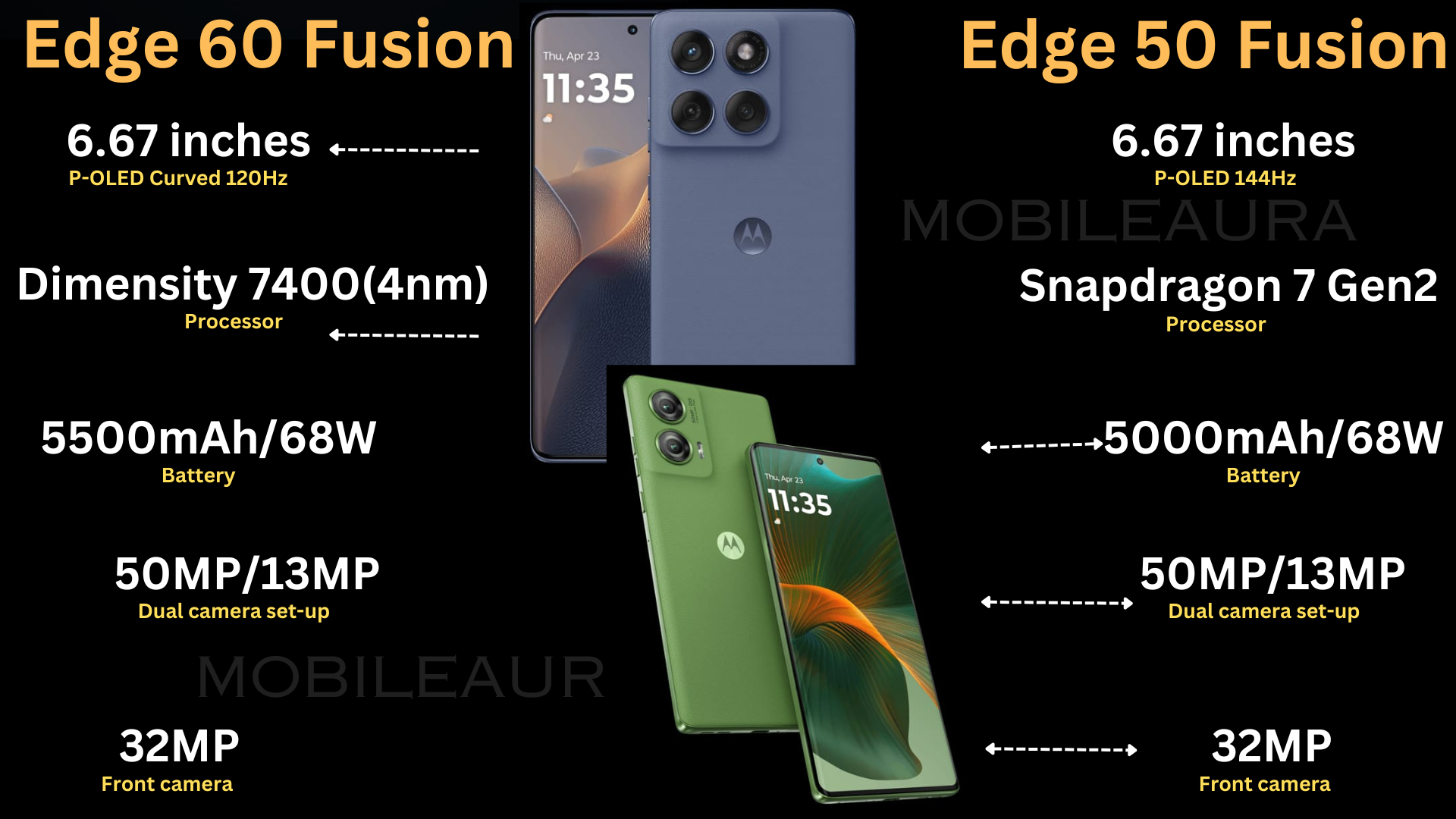
- Images Credit: motorola.in
Processor
Motorola Edge 50 Fusion Vs Motorola Edge 60 Fusion which is better? Let’s start our journy to find the best for you.
Starting with both smartphones’ processors, the Edge 60 Fusion is powered by the MediaTek Dimensity 7400 chipset, while the Edge 50 Fusion comes with the Qualcomm Snapdragon 7s Gen 2 processor.
First, let’s briefly talk about the Dimensity 7400 chipset. It is a mid-range mobile phone processor built on a 4nm process. It supports 5G connectivity seamlessly, enhances image quality through camera support, and offers smooth display performance along with power efficiency.
Now, let’s take a look at the Snapdragon 7s Gen 2 processor. This is also a mid-range smartphone chipset that mainly focuses on balanced performance, power efficiency, and gaming. It performs better in high-end gaming compared to the Dimensity. The chipset also supports AI, seamless connectivity, gaming, photography, and videography.
Now, let’s dive into the details of these powerful processors.
The Snapdragon 7s Gen 2 has an Octa-core CPU with a 2.4 GHz Quad-core Cortex A78 and a 1.95 GHz Quad-core Cortex A55. Meanwhile, the Dimensity 7400 has an Octa-core CPU with a 2.5 GHz Quad-core Cortex A78 and a 2 GHz Quad-core Cortex A55.
Both are based on a 64-bit architecture and manufactured using a 4nm process.
In terms of graphics, the 7s Gen 2 features the Adreno 710 GPU, while the Dimensity 7400 comes with the Mali-G615 MC2.
Both processors support 8GB/12GB RAM and use the LPDDR4X RAM type.
So, which one is better: the Qualcomm Snapdragon 7s Gen 2 or the MediaTek Dimensity 7400?
Both processors are good in their own areas. If you are a gamer and want a smooth gaming experience, you should go with the Snapdragon 7s Gen 2, as it delivers an impressive and smooth gaming performance with support for a 144Hz display.
On the other hand, the Dimensity 7400 is also an advanced processor that provides a decent gaming experience along with excellent support for photography and videography. Hope this helps you choose the chipset that suits your needs. For more discussion, join me on Telegram.
Display
Moving to the display, which Motorola model has a better one? The Moto Edge 50 Fusion features a P-OLED display measuring 6.67 inches with a resolution of 1080×2400 px (FHD+). The Edge 60 Fusion also comes with a P-OLED display of the same size, but it’s a curved screen with a higher resolution of 1220×2712 px (FHD+).
Talking about peak brightness, which smartphone performs better—Moto Edge 50 Fusion or Edge 60 Fusion?
Both smartphones offer impressive peak brightness. The Edge 50 Fusion supports 1600 nits, while the Edge 60 Fusion goes even higher, supporting up to 4500 nits.
In terms of HBM (High Brightness Mode), the Edge 60 Fusion again takes the lead with 1400 nits, compared to the 1200 nits of the Edge 50 Fusion.
Now let’s talk about refresh rate—can you guess which one is smoother?
If you’re thinking of the 50 Fusion, then you’re absolutely right. It supports a 144Hz refresh rate, while the 60 Fusion supports 120Hz.
Both smartphones support HDR10+ and come with screen protection.
The 50 Fusion has Corning Gorilla Glass v5, while the 60 Fusion features Corning Gorilla Glass 7i.
Both models are impressive when it comes to display—now it’s up to you to decide which one suits you better.
Cameras
Now let’s talk about which Moto Fusion has better cameras.
Both smartphones come with a dual camera setup — the main camera is a 50MP wide-angle lens along with a 13MP ultra-wide-angle lens.
- However, the 50 Fusion’s main camera supports 8x digital zoom, while the 60 Fusion does not mention a specific zoom limit, though it also supports digital zoom.
Both smartphones feature Quad Phase Detection Autofocus, OIS, and an LED flash. They support 8150×6150 pixels image resolution, exposure compensation, and ISO control. In shooting modes, both offer HDR (High Dynamic Range Mode), continuous shooting, burst mode, and macro mode. Camera features such as auto flash, touch to focus, custom watermark, filters, and face detection are available on both devices.
There is no major difference so far in the camera hardware and features. However, the difference lies in video recording capabilities. The 50 Fusion can record at 3840×2160 resolution at 30FPS and at 1920×1080 at 60FPS. On the other hand, the 60 Fusion can record at 3840×2160 at 30FPS, 1920×1080 at 120FPS, and 1280×720 at 240FPS. In terms of shooting features, the 50 Fusion supports slow-motion and dual video recording, while the 60 Fusion includes slow motion, dual recording, audio zoom, and bokeh portrait video.
That covers the back camera setup of both smartphones. Now, let’s look at the front cameras.
Both have a 32MP wide-angle selfie sensor. Although the resolution is the same, the 50 Fusion’s front camera can record at 3840×2160 and 1920×1080 at 30FPS, whereas the 60 Fusion’s front camera can record at 3840×2160 at 30FPS and 1920×1080 at 60FPS.
Connectivity
In network and connectivity, both smartphones support dual SIM slots along with 5G and 4G network connectivity. VoLTE is supported on both smartphones for crystal clear voice calls and stable communication, and GPS support is available with A-GPS and Glonass.
However, some connectivity options create a difference. The 50 Fusion supports Wi-Fi 5, Bluetooth 5.2, and impressively, NFC support too. On the other hand, the 60 Fusion supports Wi-Fi 6 and Bluetooth 5.4, but there is no NFC support in the Motorola Edge 60 Fusion.
Multimedia
In terms of multimedia, both have stereo speakers, a USB Type-C audio jack, and audio features with Dolby Atmos. There is no major difference in multimedia.
Battery
In terms of battery capacity, the 50 Fusion is packed with a 5000mAh battery, while the 60 Fusion comes with a 5500mAh battery. Both smartphones support 68W Turbo Power charging, so there is not a big difference in charging support. However, the 60 Fusion has a bigger battery than the 50 Fusion.
Read the full article and Price:
More from Motorola
In this competition, adding the Motorola Edge 50 Neo wouldn’t be wrong, as this smartphone is also impressive at its particular price range.
Also, don’t forget about the Motorola Edge 50, which comes with a 5000mAh battery, Qualcomm Snapdragon 7 Gen 1 (Accelerated Edition), and a beautiful 6.7-inch P-OLED display. However, the price of this device is higher than all the other devices mentioned in the review article.


